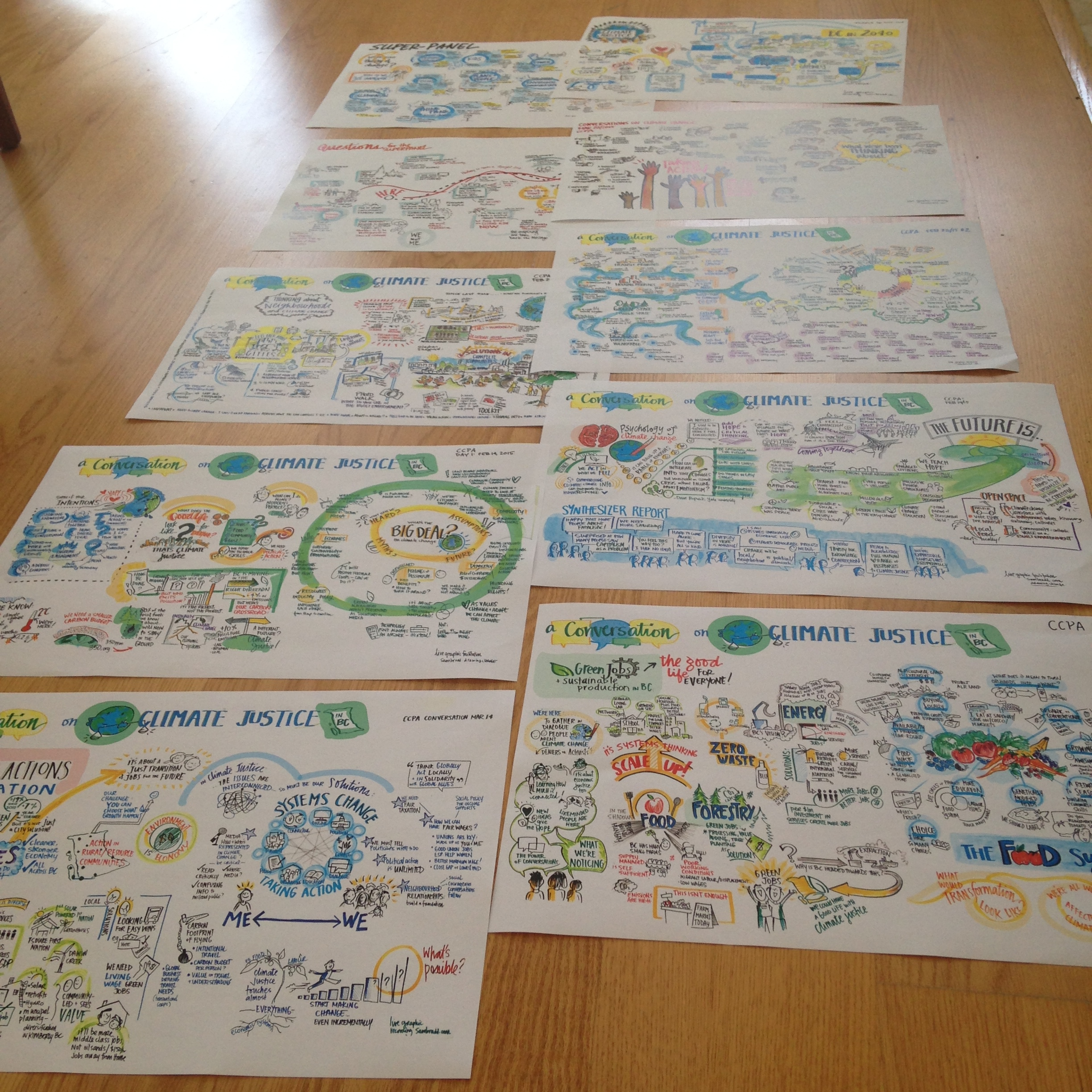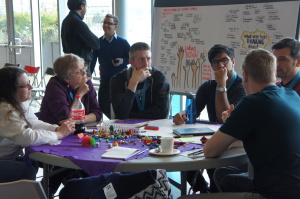Visual Facilitation and a Climate Justice Conversation
Graphic recording captured a powerful conversation about climate justice recently. A power of illustration is you can draw the future. It taps into hope, especially about climate justice. So if you have a sensitive facilitation process to lead, here are some visual facilitation elements that worked in this room.
The Climate Justice Project at the Canadian Centre for Policy Alternatives brought together 36 diverse people who were neither “climate activists” nor neither “climate change deniers” for an accelerated, 4-day conversation – to see what would emerge. If people didn’t think climate justice was relevant to their lives, or if it was too overwhelming – could a structured program in 32 hours change their position? The CCPA wanted new voices to join the conversation in a constructive, emotionally grounded, and hopeful way – because ultimately, if we all are feeling fearful and hopeless, crucial action isn’t going to happen.

It was skillfully led by facilitator Stina Brown and Marc Lee of the CCPA. Stina is an expert in climate justice facilitation change process, and Marc’s the numbers guy whose research backs up the social change we need.
Here’s some of the success factors. Have a diverse recruitment process to get the right people in the room (we had high school students to retirees!), and feed them. Use paired buddies, small groups, and limit large open-group discussions where energy can get sucked out. Acknowledge that this topic brings up emotional responses. Expert presentations had to be focussed on solutions and skills not just statistics. Powerpoint was limited to 20 minutes a day. Guest speakers brought the energy up. Different visual techniques such as visual agendas made by Stina, participant workbooks, photo walks for homework and graphic recording helped make the topic concrete.
Over four days, I created over 12 8-foot graphic recordings to help document the process. That’s over 380 square feet! (The images are not available at this point online.) Graphic recording made visible the learning and emotional transformation that was happening in the room. Looking back over an entire room whose walls were covered in pictures, the group could see how far they’d come together. They could see their beginning questions – layered with information and presentations by guest experts – shift into the later stages of planning for action. It was all there. The graphics grounded their reflection, it was part of their notes, and they could take the pictures into their lives to keep the conversation going.

For me, climate justice is about working towards a better world, together. It’s not about scarcity and fear. A lower-carbon life in BC is about safe, affordable housing, fantastic public transit, scaling up local agriculture, good-paying jobs, integrated neighbourhoods where we know each other, clean water, strong democracy, and we have publicly owned services (including Hydro power) to make it happen. The CCPA’s project “The Good Green Life” is a great video on this topic.

Participating as the graphic facilitator with the Climate Justice Project, I felt my capacity for hope grow along with the participants. The group needed to first bring up feelings of confusion and hopelessness in order to figure out what was possible. I recognize that feeling of being overwhelmed when I see an article about another environmental disaster on Facebook or in the news – it can bring up so many feelings of guilt or anger or sadness, and I don’t read it, and feel alone, and worried. But then I remember what helps me feel connected. I talk to people, I take action in my community, I take care of myself. I remember that I’m never alone. If you want to tap into that feeling, try Beautiful Solutions: “an opportunity to chart a different course”, along with the other CCPA resources.
Because of a strong facilitation process, a balance of activities, and trust between participants, an amazing transformation happened. It went from “me to we”. By day 3 of the 4 part series, participants were hungry for action, and a guest Super-panel on Day 4 helped connect participants to different groups and actions. Participants filled an entire poster with ideas for what they could do next. They left knowing climate justice is interconnected within every part of their lives, and no matter where they start, it’s going to make a difference.